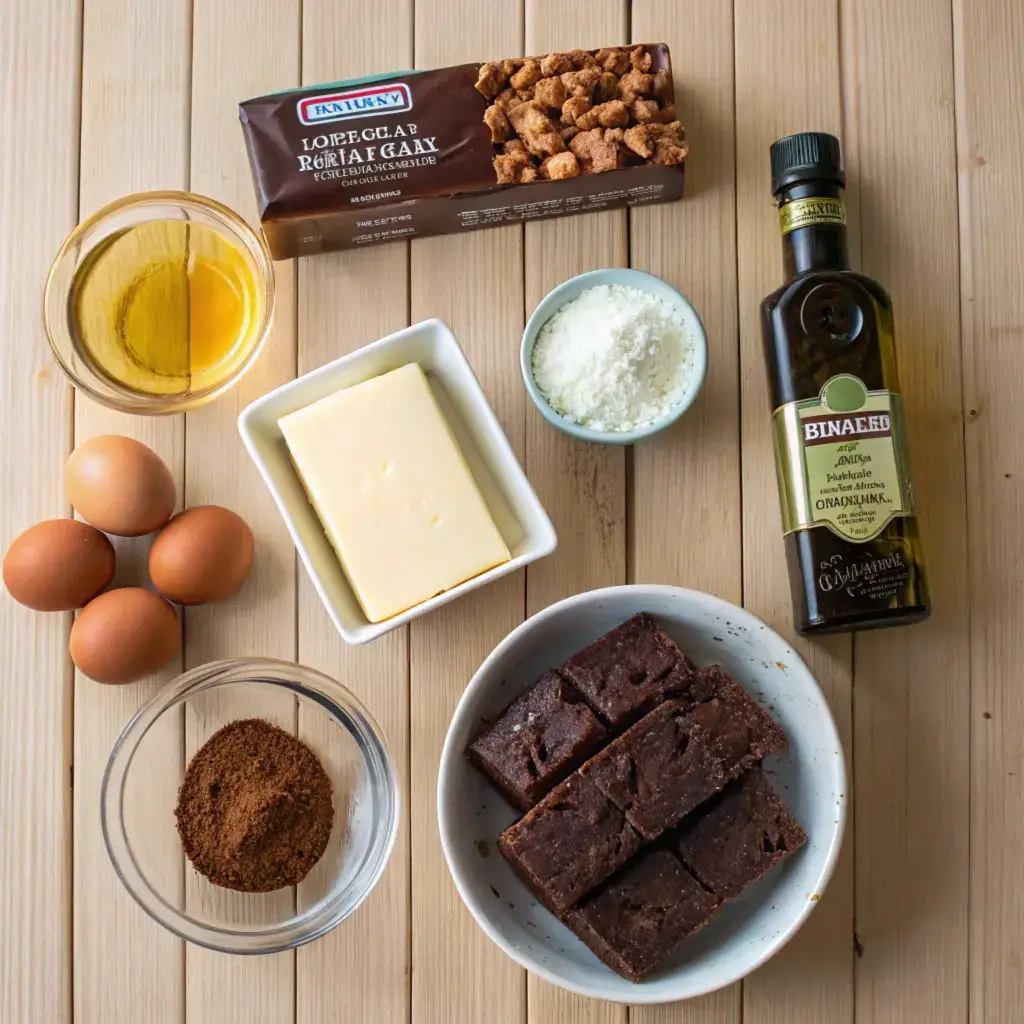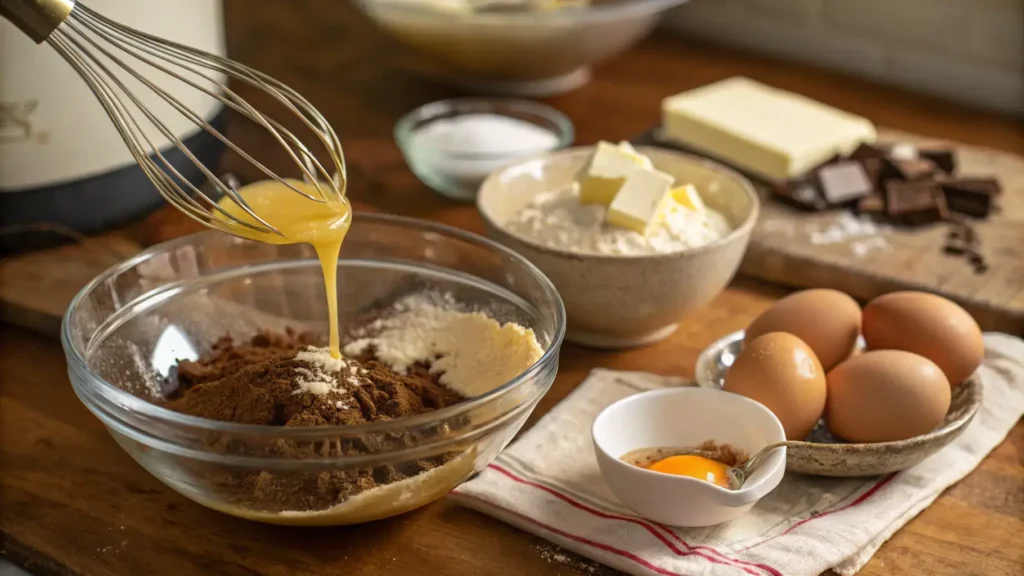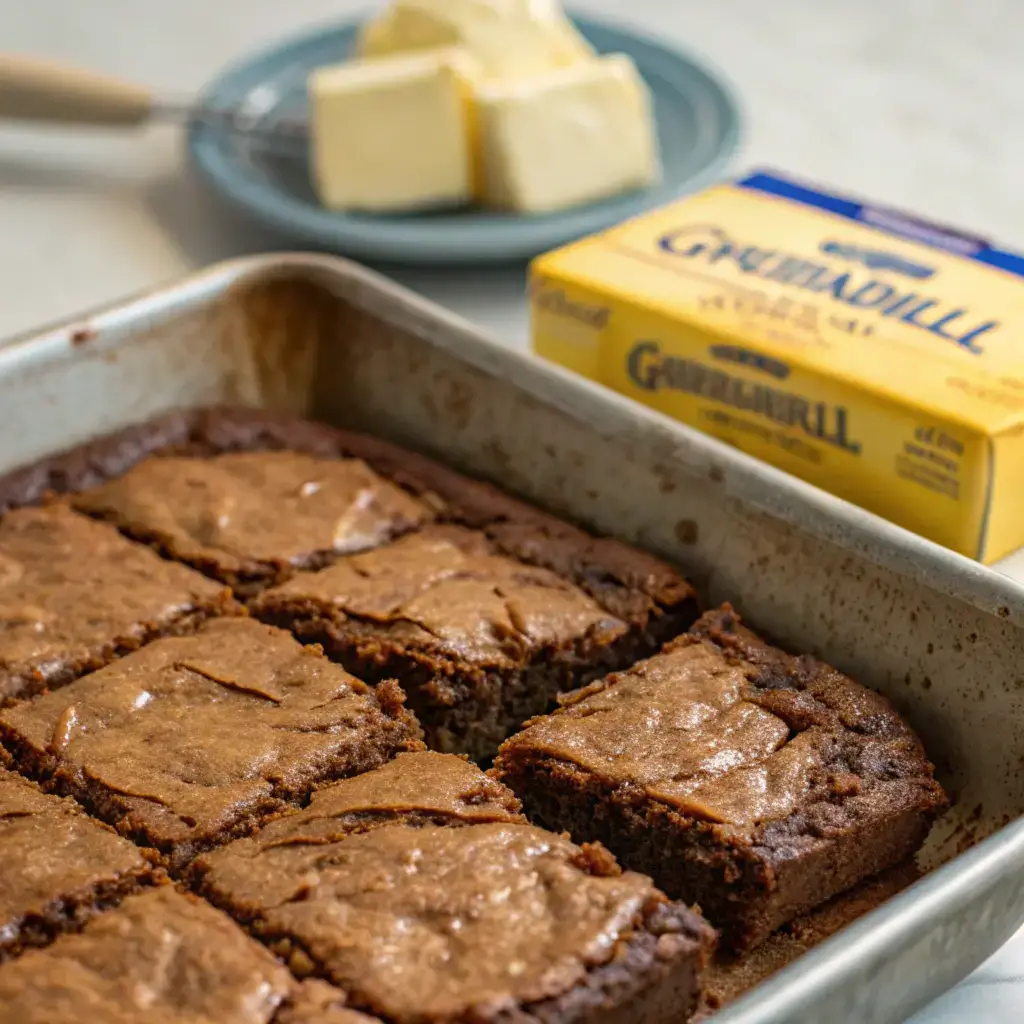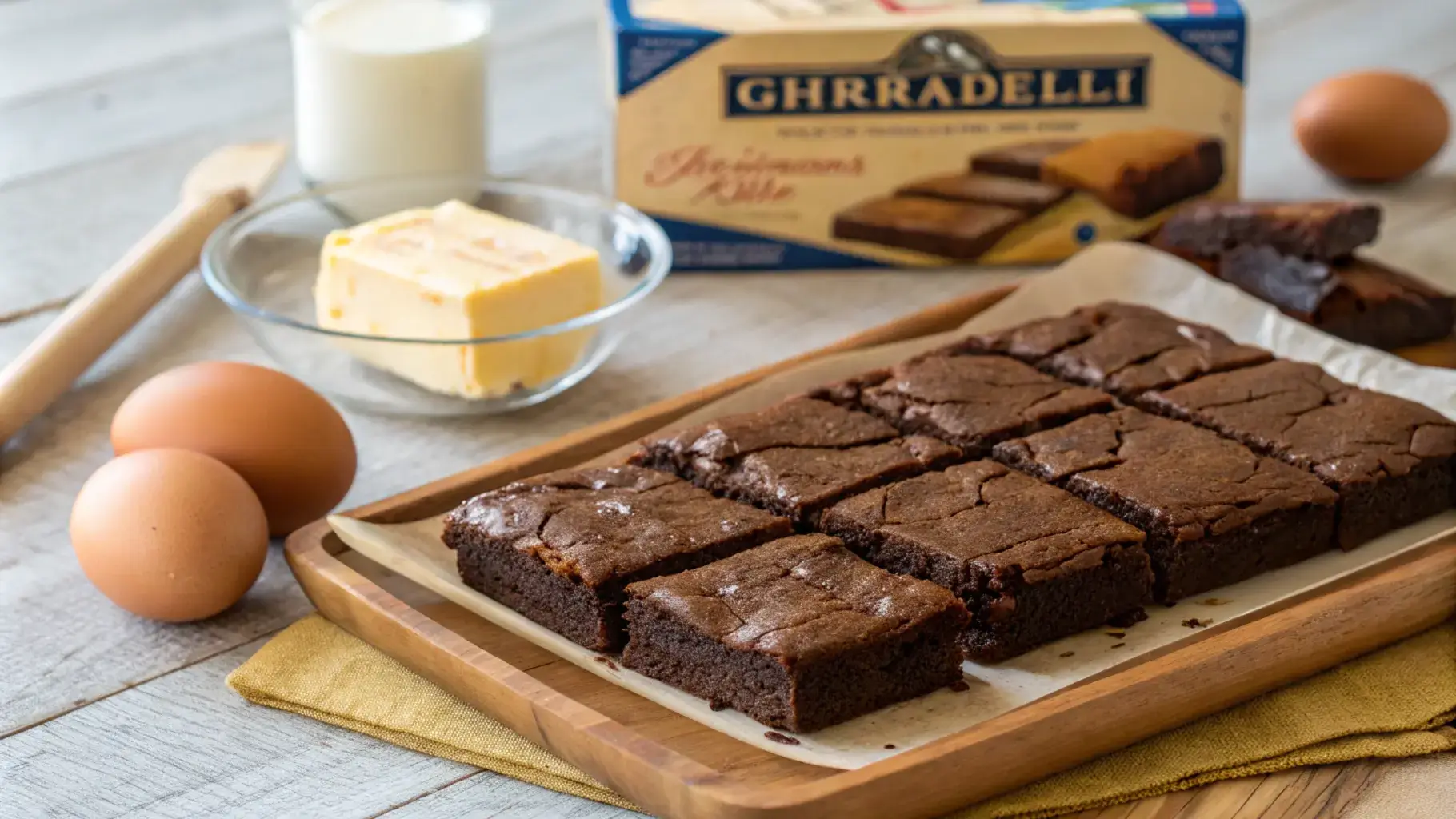When it comes to baking, the little swaps you make can have a big impact. If you’ve ever reached for oil to find the bottle empty, you might’ve wondered, Can I use butter instead of oil in Ghirardelli brownie mix? Well, the short answer is yes, but there’s a bit more to it. This article will walk you through the ins and outs of making this substitution, from how it changes texture and flavor to step-by-step guidance for nailing the process. Let’s dive into the gooey details!
Understanding the Role of Fats in Baking
The Function of Oil in Brownie Mixes
Oil plays a crucial role in brownie recipes, especially in mixes like Ghirardelli’s. It’s not just about moisture—though that’s a big part of it. Oils, being liquid fats, contribute to the soft, rich texture of brownies. They also help bind the mix together while making sure everything bakes evenly.
But here’s the kicker: oil has a neutral flavor. This means it lets the chocolatey goodness in the brownies shine through without interference. This neutrality is why vegetable oil is the standard choice in most brownie recipes.
The Impact of Butter on Texture and Flavor
Butter, on the other hand, brings more than just fat to the table. It has water content and milk solids that contribute to a firmer yet tender texture. This can slightly change the mouthfeel of your brownies, often adding a denser, richer bite.
Flavor-wise, butter adds a hint of creaminess and depth. Unlike oil, which stays in the background, butter can create a more indulgent taste that complements chocolate beautifully. For some, this is a win; for others, it may feel like the chocolate takes a backseat.
Learn more in this Ghirardelli brownie mix recipe.
Ghirardelli Brownie Mix Ingredients Overview
Key Components

The Ghirardelli brownie mix is celebrated for its rich, chocolatey flavor and indulgent texture. But have you ever wondered what makes it so special? The ingredients are designed to create a perfect balance of flavor and consistency.
Key components of the mix include:
- Cocoa Powder: Provides that deep, fudgy chocolate taste.
- Sugar: Adds sweetness while also helping with the texture.
- Flour: The structural backbone, holding everything together.
- Leavening Agents: Helps the brownies rise slightly for that soft bite.
Each ingredient works harmoniously to give Ghirardelli brownies their signature taste.
Purpose of Each Ingredient
Understanding what each ingredient does can help you see why substitutions like butter instead of oil are possible. Oil is included for moisture and uniformity, but butter can step in as it provides fat and some added flavor.
Here’s a quick breakdown:
- Cocoa Powder benefits from the fat in butter to bloom its rich flavor even further.
- Sugar dissolves better with butter’s creaminess, creating smoother textures.
- Flour binds effectively with both oil and butter, so the substitution doesn’t disrupt structure.
Switching oil for butter in the Ghirardelli mix doesn’t just “work”—it can amplify certain qualities like creaminess and richness, but knowing the mix’s composition helps you get the ratios right.
Substituting Butter for Oil: Feasibility and Methodology
Conversion Ratios
One of the most common questions when swapping oil for butter in baking is how much to use. Since butter contains water (about 15-20%), you’ll need slightly more butter to match the fat content of oil. The general rule is:
- For every 1 cup of oil, use 1 1/4 cups of butter.
This ratio ensures the texture remains moist without being too heavy. For smaller quantities, like the amount in a typical Ghirardelli brownie mix, simply multiply the oil measurement by 1.25 to find the butter equivalent.
For example, if the box calls for 1/2 cup of oil, you’ll need:
- 1/2 cup × 1.25 = 5/8 cup, or about 10 tablespoons of butter.
Preparation Steps

Substituting butter for oil is straightforward, but following these steps ensures a smooth baking process:
- Melt the Butter: Use unsalted butter and melt it completely before measuring. This provides consistency in your brownies.
- Let It Cool Slightly: Avoid adding hot butter directly to the mix, as it can partially cook the eggs. Let it cool for 2-3 minutes.
- Combine Gradually: Add the melted butter to the brownie mix gradually, stirring gently to avoid overmixing.
By replacing oil with butter, you’re not just changing an ingredient—you’re tweaking the chemistry of the batter. Butter creates a slightly denser mixture, so keep an eye on the baking time.
Comparative Analysis: Butter vs. Oil in Brownies
Texture Differences
The texture is one of the most noticeable changes when using butter instead of oil in Ghirardelli brownie mix. Oil-based brownies are often described as moist, soft, and slightly chewy. Since oil is a liquid fat, it distributes evenly throughout the batter, resulting in a uniform texture.
Butter, however, introduces water and milk solids into the mix, which can slightly alter the crumb. Brownies made with butter tend to be denser and may have a firmer, more cake-like quality depending on the ratio used.
For fans of a fudgier texture, butter might be the way to go, but if you’re chasing a chewy consistency, sticking with oil might be your best bet.
Flavor Profiles
Flavor is where butter truly shines. While oil has a neutral taste, butter brings its own rich, creamy flavor to the brownies. This can enhance the overall taste, making the chocolate feel more luxurious and decadent.
That said, butter’s distinct taste might slightly overpower the chocolate, especially if you’re using darker cocoa blends like those in Ghirardelli mixes. For a pure chocolate experience, oil lets the cocoa take center stage.
Which Should You Choose?
If you prefer a more indulgent brownie with a rich, buttery undertone, swapping oil for butter is a great option. On the other hand, if you’re all about a chewy, chocolate-forward treat, oil might be the better choice. Ultimately, it depends on your taste and texture preferences.
Health Implications of Using Butter Instead of Oil
Nutritional Comparison
When swapping butter for oil in Ghirardelli brownie mix, the nutritional differences are worth noting. Butter and oil both provide fat, but their compositions vary significantly:
- Oil (vegetable or canola): 100% fat, with no additional nutrients. It’s a concentrated source of calories but is often lower in saturated fats compared to butter.
- Butter: Contains about 80% fat, with the rest made up of water and milk solids. It’s richer in saturated fats and includes small amounts of vitamins like A and D.
This means that brownies made with butter will have slightly more saturated fat and cholesterol compared to those made with oil. However, butter offers a natural flavor that many find more appealing, which can justify the trade-off in small amounts.
Dietary Considerations
Your choice between butter and oil might also depend on dietary preferences or restrictions. For instance:
- Low-fat or calorie-conscious diets: Oil may be the better option due to its lower calorie density when compared by weight.
- Keto or high-fat diets: Butter aligns better with these dietary plans, thanks to its fat composition and trace amounts of beneficial compounds like butyrate.
It’s also important to consider personal health conditions, like heart disease, where saturated fats found in butter might need to be limited.
Expert Opinions on Butter Substitution in Brownie Mixes
Insights from Professional Bakers
Professional bakers often agree that swapping butter for oil can enhance flavor in certain baked goods, brownies included. They emphasize that butter’s rich taste elevates the indulgent experience of chocolate desserts like Ghirardelli brownies.
However, experts caution that butter changes the moisture content, which can affect the outcome if not handled carefully. Many recommend melting and cooling the butter properly to ensure a smooth integration into the mix.
Some bakers even suggest using browned butter—a technique where the butter is gently cooked until it develops a nutty aroma—to add a layer of complexity to the flavor. This step can turn a standard brownie mix into something bakery-worthy.
Recommendations from Ghirardelli
Ghirardelli itself acknowledges that substitutions can be made, but the brand’s official advice encourages careful attention to ratios and preparation. They suggest using unsalted butter to avoid overpowering the chocolate flavor with additional salt.
Interestingly, some Ghirardelli recipes call for butter instead of oil, signaling that the brand recognizes butter’s appeal in certain contexts. Their brownie mix is versatile enough to accommodate this substitution while still delivering delicious results.
Step-by-Step Guide to Substituting Butter in Ghirardelli Brownie Mix
If you’re ready to try using butter instead of oil in Ghirardelli brownie mix, follow this step-by-step guide to ensure success.
Required Ingredients
To make the swap, you’ll need:
- 1 Box of Ghirardelli Brownie Mix: Choose your favorite variety (classic, dark chocolate, or double chocolate).
- Melted Unsalted Butter: Use the conversion ratio (1 cup of oil = 1 1/4 cups butter).
- Eggs: As called for on the box.
- Water: If specified in the instructions.
Detailed Instructions
- Preheat Your Oven
Follow the temperature instructions on the Ghirardelli brownie mix box. Grease your pan or line it with parchment paper for easy cleanup. - Melt the Butter
Melt the required amount of butter in a microwave or over the stove. Allow it to cool slightly before using. This step is crucial to prevent the heat from scrambling the eggs when mixed. - Combine Wet Ingredients
In a large mixing bowl, whisk together the melted butter, eggs, and water. Stir until well blended. - Incorporate the Brownie Mix
Add the Ghirardelli brownie mix to the wet ingredients. Stir gently until all the dry mix is fully incorporated. Avoid overmixing, as this can make the brownies dense. - Pour and Spread the Batter
Transfer the batter into your prepared pan. Spread it evenly to ensure uniform baking. - Bake According to Instructions
Bake the brownies for the time specified on the box. However, check them a few minutes earlier, as butter can sometimes cause the brownies to bake slightly faster. - Cool Before Cutting
Allow the brownies to cool completely in the pan before slicing. This step helps them set and makes cutting easier.

Common Mistakes to Avoid When Substituting Butter
Swapping butter for oil in Ghirardelli brownie mix is simple, but a few common pitfalls can lead to less-than-perfect results. Avoid these mistakes to ensure your brownies come out as intended.
Overlooking Cooling Time
One of the most frequent mistakes is skipping the cooling period for melted butter. Adding hot butter to the brownie mix can partially cook the eggs or create lumps in the batter. Always let the butter cool for a few minutes before combining it with other ingredients.
Using Salted Butter Without Adjustments
If you use salted butter instead of unsalted, the additional salt can throw off the flavor balance, especially in a sweet dessert. While it’s not a dealbreaker, you may need to reduce or eliminate any added salt in the recipe.
Incorrect Measurements
Butter and oil aren’t an exact one-to-one swap due to the water content in butter. Using the wrong ratio can lead to dry brownies or batter that’s too wet. Stick to the conversion rule of 1 cup oil = 1 1/4 cups butter.
Overmixing the Batter
Overmixing is a common mistake regardless of whether you’re using butter or oil. It develops the gluten in the flour, which can make your brownies tougher and less fudgy. Mix just until all ingredients are incorporated.
Baking at the Wrong Temperature
Butter can slightly alter the baking process, so using the wrong oven temperature can affect the final texture. Stick to the instructions on the box and monitor the brownies closely as they bake.
Enhancing Brownie Recipes with Butter Substitution
Using butter instead of oil in Ghirardelli brownie mix opens up opportunities to take your brownies to the next level. With a few simple tweaks, you can create a dessert that feels custom-made.
Adding Mix-Ins
Butter’s rich, creamy flavor pairs beautifully with various add-ins. Consider folding these into your batter for a unique twist:
- Chocolate Chunks or Chips: Intensify the chocolate experience by adding dark, milk, or white chocolate pieces.
- Nuts: Pecans, walnuts, or almonds add a delightful crunch.
- Caramel Swirls: Add dollops of caramel to the batter for a gooey surprise.
- Fruit: Dried cherries or raspberries provide a tangy contrast to the sweetness.
These additions work well with the buttery undertones, enhancing the flavor without overwhelming the classic brownie taste.
Flavor Variations
Butter is a fantastic base for infusing subtle flavors into your brownies. Try these ideas:
- Browned Butter: Toast the butter slightly before adding it to create a nutty, caramelized flavor.
- Vanilla Extract: Mix in a teaspoon of pure vanilla extract for added depth.
- Espresso Powder: A pinch of espresso powder can enhance the chocolate flavor without making the brownies taste like coffee.
Topping Ideas
The use of butter often results in a glossy top crust on brownies. Take advantage of this by adding decorative or flavorful toppings:
- Sprinkle Sea Salt: A light dusting of flaky sea salt enhances the sweetness and complements the butter.
- Dust with Powdered Sugar: For a classic, elegant finish.
- Frosting: Spread a thin layer of cream cheese or chocolate ganache frosting for extra indulgence.
Alternative Fat Substitutes for Butter or Oil in Ghirardelli Brownie Mix
If you’re exploring options beyond using butter instead of oil in Ghirardelli brownie mix, you’ll be glad to know there are other versatile substitutes to try. These alternatives allow you to adjust the flavor, texture, and even nutritional profile of your brownies, all while keeping the mix as indulgent as ever.
Using Margarine Instead of Oil in Ghirardelli Brownie Mix
Margarine is a common stand-in for both butter and oil in brownie recipes. Like butter, margarine contains water and fat, but its flavor is often more neutral. While margarine can achieve a texture similar to butter-based brownies, it lacks the creamy richness that butter offers.
- Pros: Affordable, widely available, and vegan-friendly options are easy to find.
- Cons: May contain additives and doesn’t offer the same depth of flavor as butter.
Substituting Coconut Oil for Butter or Oil in Ghirardelli Brownie Mix
Coconut oil is another excellent option, particularly for those seeking a plant-based alternative. Its solid state at room temperature mimics butter’s texture, and its mild coconut flavor pairs surprisingly well with chocolate.
- Pros: Provides a subtle tropical flavor; ideal for dairy-free or vegan diets.
- Cons: Slightly alters the flavor profile and can be more expensive than other substitutes.
Replacing Oil with Applesauce in Ghirardelli Brownie Mix
For a healthier, lower-fat alternative, unsweetened applesauce is a great choice. While it doesn’t replicate butter’s creamy consistency, applesauce ensures your brownies stay moist and tender.
- Pros: Low in fat, naturally sweet, and adds moisture.
- Cons: Can create a denser texture that’s less fudgy.
Using Greek Yogurt Instead of Oil in Ghirardelli Brownie Mix
Greek yogurt is a protein-rich substitute that adds moisture and a slight tang to your brownies. Though it’s not as common as other alternatives, it works well in recipes that allow for a thicker batter.
- Pros: High in protein and adds a unique flavor dimension.
- Cons: Can result in overly dense brownies if not carefully balanced.
Avocado as a Substitute for Butter or Oil in Ghirardelli Brownie Mix
For an unconventional yet effective alternative, mashed avocado can replace butter or oil in your brownie mix. Its creamy texture yields a fudgy consistency, and its mild flavor is easily masked by the chocolate.
- Pros: Packed with heart-healthy fats and delivers a smooth, rich texture.
- Cons: May slightly alter the color and flavor of the brownies.
Packed with heart-healthy fats and delivers a smooth, rich texture.
FAQs
What ingredients are needed for Ghirardelli brownie mix?
To prepare Ghirardelli brownie mix, you typically need just a few pantry staples:
- Eggs: Usually one or two, depending on the mix size.
- Water: Helps hydrate the mix and combine ingredients.
- Vegetable Oil (or Butter): Provides the necessary fat for moisture and texture.
These simple ingredients come together with the mix to create rich, chocolatey brownies.
For a complete list, check out this guide on ingredients for Ghirardelli brownie mix.
How to double the recipe for Ghirardelli brownie mix?
Doubling the recipe is straightforward. Here’s how:
- Double All Ingredients: For instance, if the mix calls for 1 egg, 1/4 cup of oil, and 1/4 cup of water, use 2 eggs, 1/2 cup of oil, and 1/2 cup of water.
- Use a Larger Pan: A 9×13-inch pan works well for a doubled recipe, ensuring the batter spreads evenly.
- Adjust Baking Time: Check for doneness 5–10 minutes beyond the original bake time, as a larger batch may take slightly longer.
Always follow the same preparation steps, and remember not to overmix the batter!
Check out this detailed guide on how to double recipe for Ghirardelli brownie mix
What can I add to brownie mix to make it better?
There are plenty of ways to elevate the flavor and texture of brownies. Try these ideas:
- Mix-Ins: Add chocolate chips, nuts, or dried fruits.
- Flavor Enhancers: A teaspoon of vanilla extract or a pinch of espresso powder can deepen the chocolate flavor.
- Toppings: Sprinkle with flaky sea salt, powdered sugar, or drizzle caramel or ganache.
- Swirls: Incorporate peanut butter, cream cheese, or Nutella for a marbled effect.
These additions can take a simple boxed mix to bakery-quality results.
For more ideas, explore this guide on what can I add to brownie mix to make it better.
What are the instructions for brownie mix?
The steps may vary slightly depending on the specific Ghirardelli mix, but here are the general instructions:
- Preheat Oven: Set to the temperature listed on the box, typically 325°F or 350°F.
- Prepare the Pan: Grease the pan or line it with parchment paper.
- Mix Ingredients: Combine the brownie mix, eggs, oil (or butter), and water in a bowl until just blended.
- Pour Batter: Spread the batter evenly into the prepared pan.
- Bake: Bake for the time specified on the box, based on the pan size. Use a toothpick to check doneness—it should come out with moist crumbs.
- Cool and Serve: Let the brownies cool before cutting into squares.
Following these instructions ensures perfect brownies every time!
Conclusion
Swapping butter for oil in Ghirardelli brownie mix is a simple adjustment that can bring a new depth of flavor and texture to your favorite dessert. Whether you’re seeking the creamy richness of butter or prefer the neutral consistency of oil, the choice ultimately comes down to personal taste. By understanding how fats function in baking, carefully measuring your ingredients, and following the right techniques, you can create brownies that are fudgy, moist, and utterly satisfying.
Additionally, exploring mix-ins, alternative substitutes, and expert tips ensures your brownies turn out just the way you like them, every time. With these insights, you’re ready to bake confidently and enjoy the delicious results. Now, it’s time to grab that Ghirardelli mix and get baking—your perfect batch of brownies awaits!

